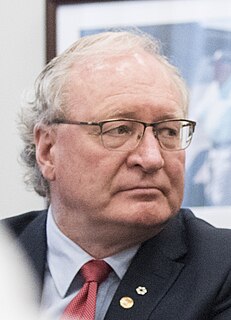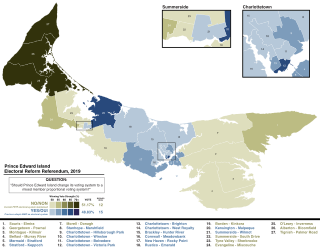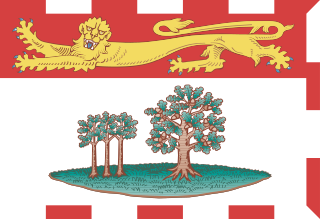Plurality voting is an electoral system in which each voter is allowed to vote for only one candidate, and the candidate who polls the most among their counterparts is elected. In a system based on single-member districts, it may be called first-past-the-post (FPTP), single-choice voting, simple plurality or relative/simple majority. In a system based on multi-member districts, it may be referred to as winner-takes-all or bloc voting. The system is often used to elect members of a legislative assembly or executive officers. It is the most common form of the system, and is used in most elections in the United States, the lower house in India, elections to the House of Commons and English local elections in the United Kingdom and Canada.
National referendums are seldom used in Canada. The first two referendums saw voters in Quebec and the remainder of Canada take dramatically opposing stands, the third saw most of the voters take a stand dramatically opposed to that of the politicians in power.

The Electoral Reform Society (ERS) is a political pressure group based in the United Kingdom which promotes electoral reform. It seeks to replace the first-past-the-post voting system with one of proportional representation, advocating the single transferable vote. It is the world's oldest operating organisation concerned with political and electoral reform.
Canada holds elections for legislatures or governments in several jurisdictions: nationally (federally), provincially and territorially, and municipally. Elections are also held for self-governing First Nations and for many other public and private organizations including corporations and trade unions. Municipal elections can also be held for both upper-tier and lower-tier governments. Formal elections have occurred in Canada since at least 1792, when both Upper Canada and Lower Canada had their first elections.

A referendum was held in the Canadian province of British Columbia on May 17, 2005, to determine whether or not to adopt the recommendation of the Citizens' Assembly on Electoral Reform to replace the existing first-past-the-post electoral system (FPTP) with a single transferable vote system (BC-STV). It was held in conjunction with the BC Legislative Assembly election of 2005. Voters were given two ballots at that time: a ballot to vote for a Member of the Legislative Assembly of British Columbia (MLA) in their constituency and a referendum ballot. The referendum received considerable support from the electorate but failed in meeting the demanding threshold that had been set. A second referendum was held in 2009.

Robert Watson Joseph Ghiz is a Canadian politician who served as the 31st Premier of Prince Edward Island from 2007 to 2015. He is the son of the 27th Premier, Joe Ghiz. On November 13, 2014 Ghiz announced he would be resigning as Premier in early 2015 as soon as the Liberal Party elected a new leader.
The politics of Prince Edward Island are centred on a provincial government resembling that of the other Canadian provinces. The capital of the province of Prince Edward Island is Charlottetown, where reside the premier, provincial legislature, lieutenant-governor and cabinet.
A referendum was held in the Canadian province of Prince Edward Island on November 28, 2005 to determine whether to adopt the Mixed Member Proportional (MMP) system as recommended by the Prince Edward Island Electoral Reform Commission in 2003.
Richard Brown is a Canadian politician, who was elected to the Legislative Assembly of Prince Edward Island in the 2007 provincial election. He represented the electoral district of Charlottetown-Victoria Park as a member of the Liberal Party.
Robert Vessey is a Canadian politician. He was elected to the Legislative Assembly of Prince Edward Island in the 2007 provincial election and represented the electoral district of York-Oyster Bed as a member of the Liberal Party until 2015.
Electoral reform is change in electoral systems to improve how public desires are expressed in election results. That can include reforms of:

The 2015 Prince Edward Island general election was held May 4, 2015, to elect members of the 65th General Assembly of Prince Edward Island. Under amendments passed by the Legislative Assembly of Prince Edward Island in 2008, Prince Edward Island elections are usually held on the first Monday of October in the fourth calendar year, unless it is dissolved earlier by the Lieutenant Governor of Prince Edward Island due to a motion of no confidence. The current government had hinted that an election would be held "before Mother's Day" 2015, and such a dissolution would avoid any conflicts with the next federal election, expected to be held in October 2015.

The 2019 Prince Edward Island general election was held to elect the 27 members of the 66th General Assembly of Prince Edward Island in Atlantic Canada. The election in 26 of the electoral districts was held April 23, 2019, while the vote in Charlottetown-Hillsborough Park was cancelled due to the death of the Green party's candidate, with a by-election to be held no later than July 19, 2019.
The House of Commons Special Committee on Electoral Reform (ERRE) was a special committee of the House of Commons of Canada established during the 42nd Canadian Parliament to investigate reforms to the Canadian electoral system. The formation of "an all-party Parliamentary committee to review... [electoral] reforms" was an election promise by Liberal Party leader Justin Trudeau in the 2015 federal election. After becoming Prime Minister, Trudeau indicated the formation of a special committee was a priority in his mandate letter for Minister of Democratic Institutions Maryam Monsef. Shortly after the committee submitted its report to parliament on December 1, 2016, Monsef was transferred to the position of the Minister of Status of Women and Karina Gould took over the electoral reform file. Shortly after taking her position Gould announced that the government would no longer be pursuing reform of the electoral system, stating "It has become evident that the broad support needed among Canadians for a change of this magnitude does not exist".

A referendum on electoral reform took place by mail-in ballot between October 22 and December 7, 2018, in the Canadian province of British Columbia. This was British Columbia's third referendum on electoral reform since 2005.

Rural–urban proportional representation (RUP), also called Flexible District PR, is a hybrid proportional system designed by Fair Vote Canada with the intention of meeting the special challenges of Canada's geography, which includes wide-flung, sparsely-populated areas. As conceived in general terms by Fair Vote Canada, the rural–urban proportional model combines the use of multi-member ridings and top-up seats to meet the different needs of both rural and urban areas, while protecting the objective of proportionality. Sweden, Denmark and Iceland use similar voting models.

A referendum on electoral reform was held on April 23, 2019 in the Canadian province of Prince Edward Island – simultaneously with the 2019 provincial election – to determine if the province should adopt a mixed-member proportional representation voting system (MMP). The referendum was not binding, as neither option received majority support in 60% or more of the province's 27 electoral districts, however the popular vote was a narrow majority in favour of keeping the existing first-past-the-post system.
Charlottetown-Hillsborough Park is a provincial electoral district for the Legislative Assembly of Prince Edward Island, Canada. It was created prior to the 2019 election from parts of the former districts Tracadie-Hillsborough Park and York-Oyster Bed.











